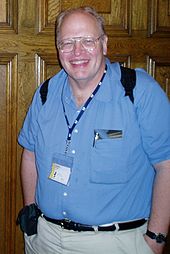Jim Gettys
Jim Gettys (born October 15, 1953 ) is an American programmer , he developed the HTTP / 1.1 standard and played a decisive role in the development of the X Window System .
Life
education
From 1969 to 1972 Jim Gettys attended Phillips Academy High School in Massachusetts , near Boston . After graduating in 1972, he attended the Massachusetts Institute of Technology , where he graduated in 1978 with a Bachelor of Science in Earth and Planetary Sciences.
Career
In the same year Gettys began working as a software developer at the Harvard-Smithsonian Center for Astrophysics . During this time he worked on software for a digital ground aid device for a small helium-cooled infrared telescope. This technique was developed for Spacelab 2.
After working at the Institute for Advanced Study in Princeton, New Jersey from 1981 to 1983 , he moved to MIT in 1983, where he was a visiting professor from 1983 to June 1987 . During this time he designed the X Window System together with Robert W Scheifler and worked on the Xlib program library.
In January 1987 he started his work as a software developer at Digital Equipment Corporation , where he continued his work on the X Windows System and published version 11 of the X Window System in October 1990. During this time he also worked on and participated in the DECstation 3100 engage in research on multimedia systems and audio and video conference calls in the network.
From 1995 to 2000 he worked as a visiting scholar for the World Wide Web Consortium , where he deals with the HTTP standard and is also working on it. In 1996 he published the first specification HTTP / 1.1 , which is used today in the form of the IETF standard on the World Wide Web . This change in the HTTP standard not only made the protocol more performant , but also reduced the network load.
After completing his employment, he worked at Hewlett-Packard until 2005 . Together with Keith Packard, he worked on a revision of the basis of the X Window System architecture, these changes led to damage and composite extensions. During this time, he also volunteered on the X.Org Foundation's board of trustees .
From 2006 to January 2009 he was Vice President for Software in the One-Laptop-per-Child project, the goal of which was to develop a laptop with a production price of $ 100. Gettys was responsible for the laptop's system software.
From June 2009 until February 2015 he worked at Alcatel-Lucent Bell Labs as a software developer. During this time he begins work on the bufferbloat problem, which he continues to this day. He published several papers on this topic.
After he was employed as an Access Advisor at Googel from October 2014 to July 2015 and in the course of this worked on the OnHub project, he has been self-employed as Debloater in Chief since 2015 and dedicates his time to the bufferbloat problem.
Awards
He was awarded the Internet plumber of the year 1997 for his work on the HTTP standard HTTP / 1.1.
Together with his colleagues Bob Scheifler, Phil Karlton, Ralph Swick, Keith Packard and Smokey Wallace, he received the USENIX Lifetime Achievement Award in 1999 for his work on the X Window System .
Honorary positions
Jim Gettys serves on the Board of Trustees of the Gnome Foundation and the Board of Trustees of the X.ORG Foundation.
Web links
Individual evidence
- ↑ LinkedIn: Jim Gettys. Retrieved May 19, 2019 .
- ^ The X window system. April 1, 1986, accessed on May 19, 2019 (English).
- ↑ Xlib C Language X Interface. 1985, accessed May 19, 2019 .
- ↑ The X window system, version October 11 , 1990, accessed on May 19, 2019 .
- ↑ Handhelds.org Jim Gettys ( Memento of May 11, 2009 in the Internet Archive )
- ^ Hypertext transfer protocol - HTTP / 1.1. 1996, accessed on May 19, 2019 .
- ↑ The (re) architecture of the x window system. 2004, accessed on May 19, 2019 (English).
- ↑ Bufferbloat FAQ
- ↑ Internet plumber of the year 1997. Retrieved on May 19, 2019 (English).
- ^ Past Winners of the USENIX Lifetime Achievement Award. Retrieved May 19, 2019 .
| personal data | |
|---|---|
| SURNAME | Gettys, Jim |
| BRIEF DESCRIPTION | American programmer |
| DATE OF BIRTH | October 15, 1953 |
